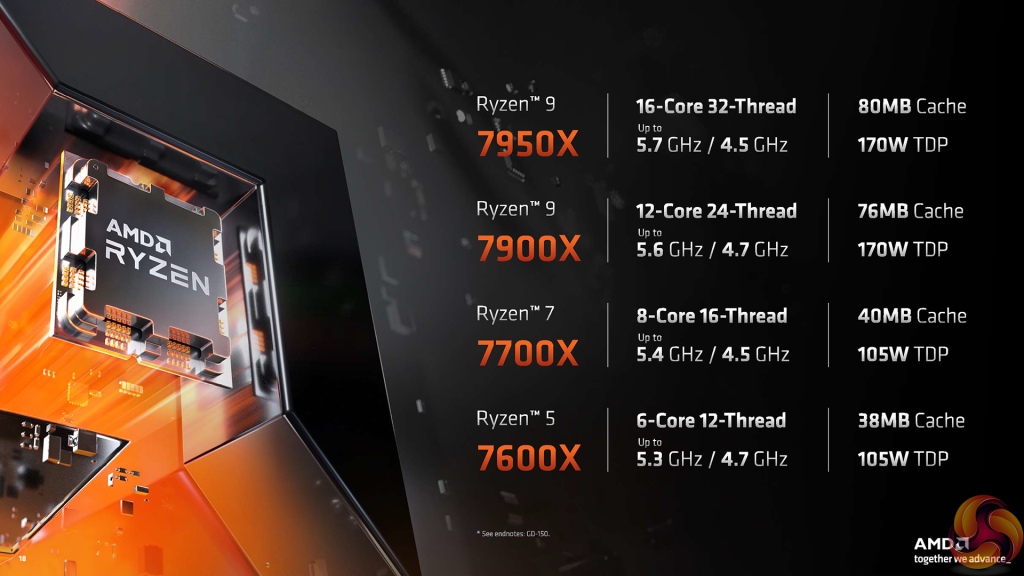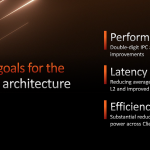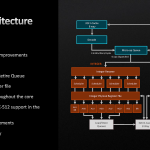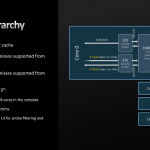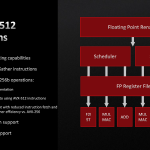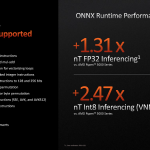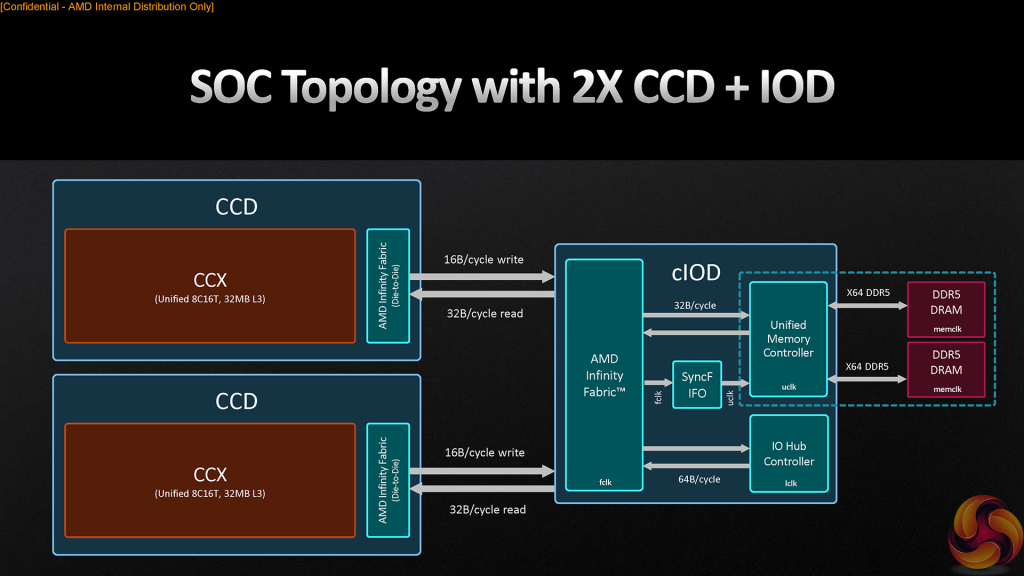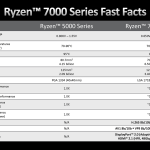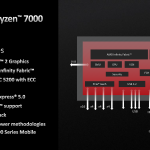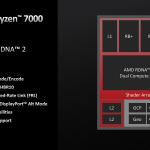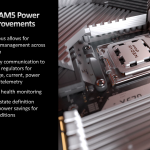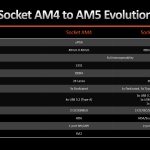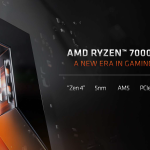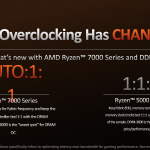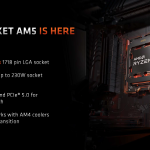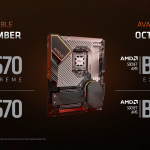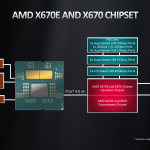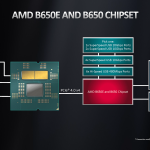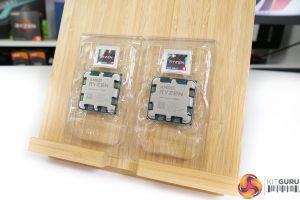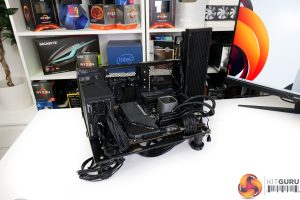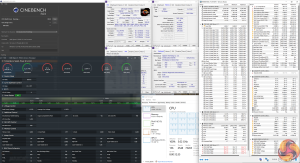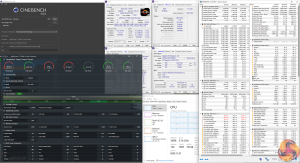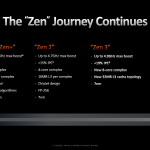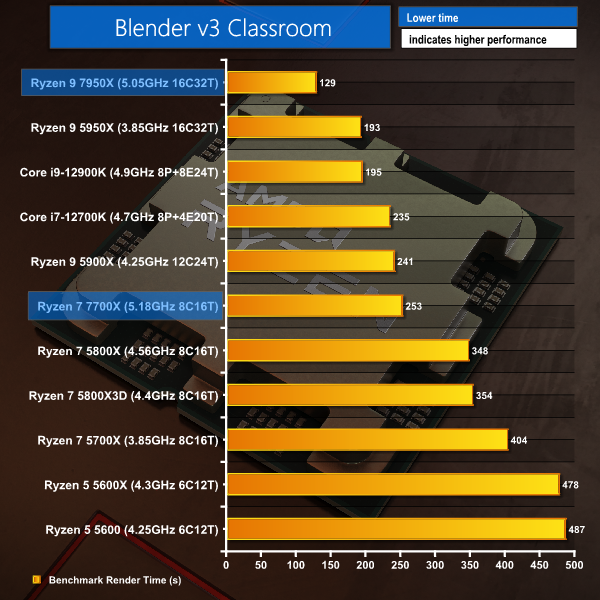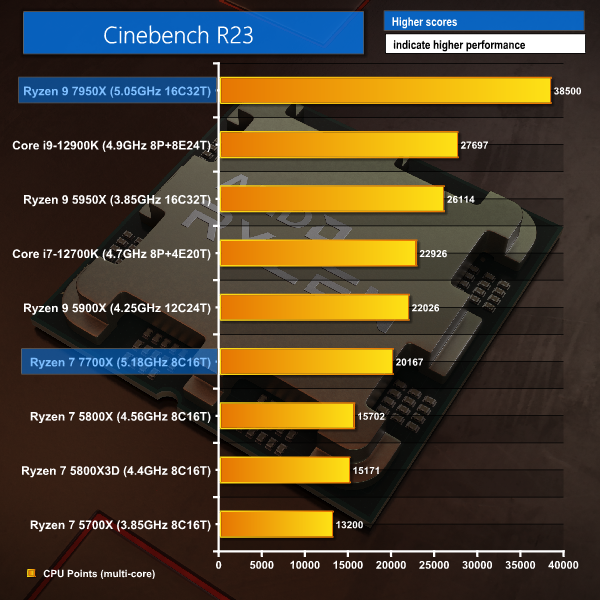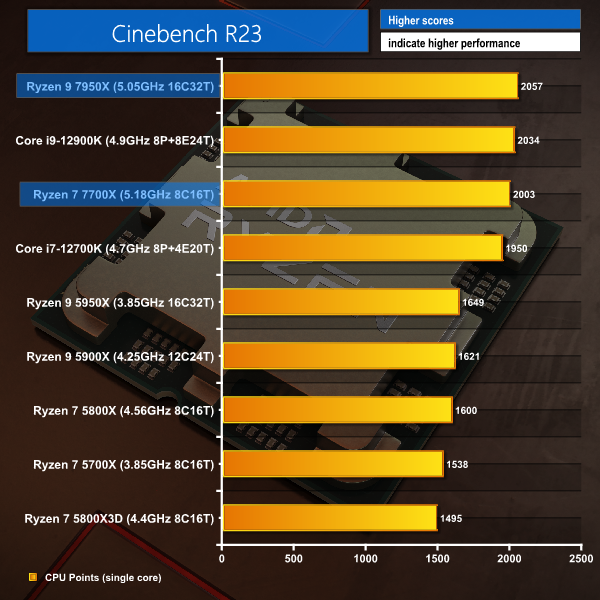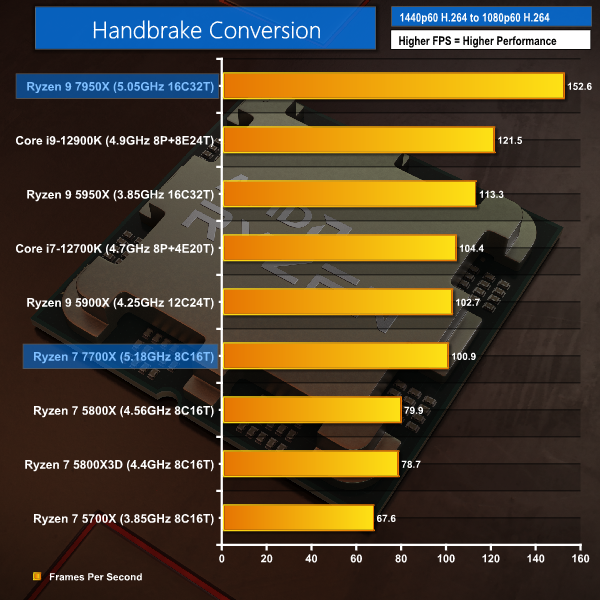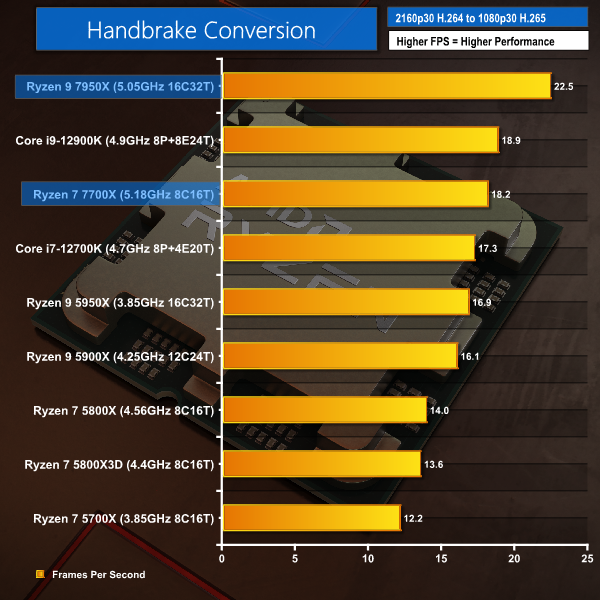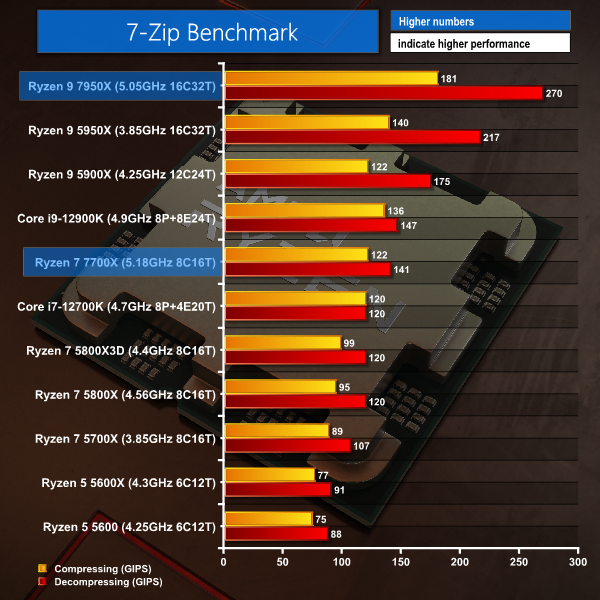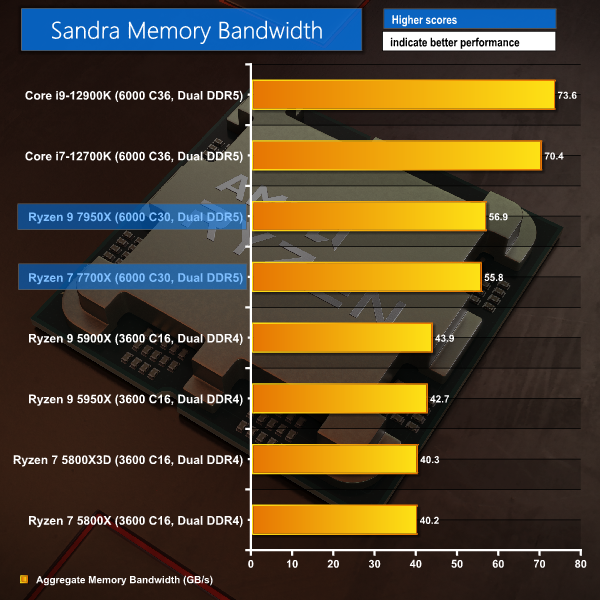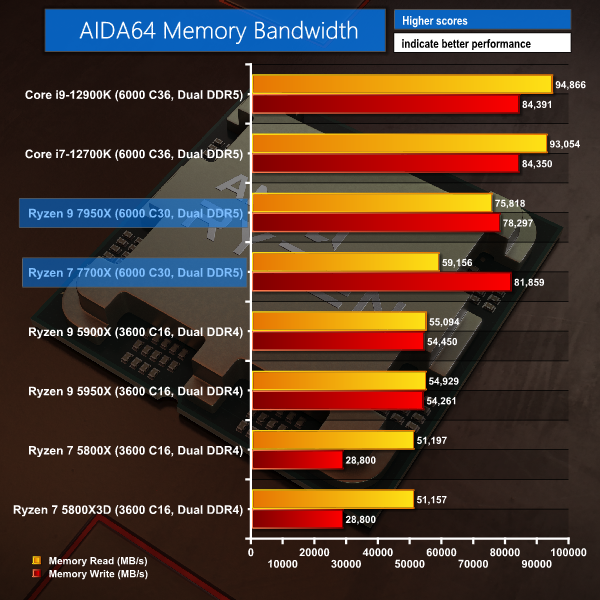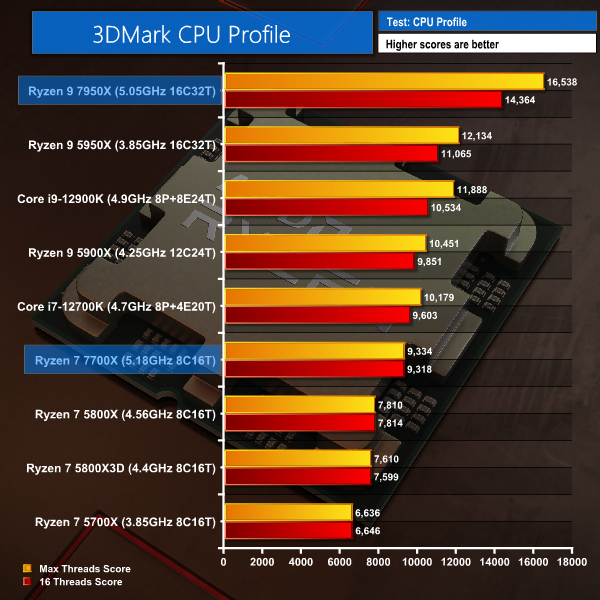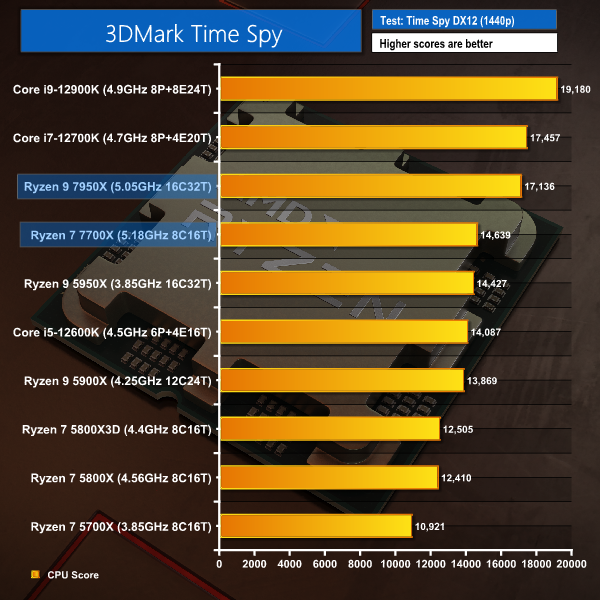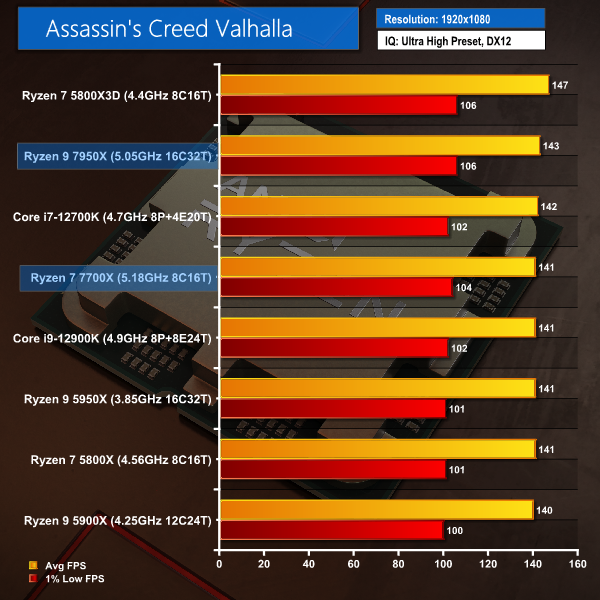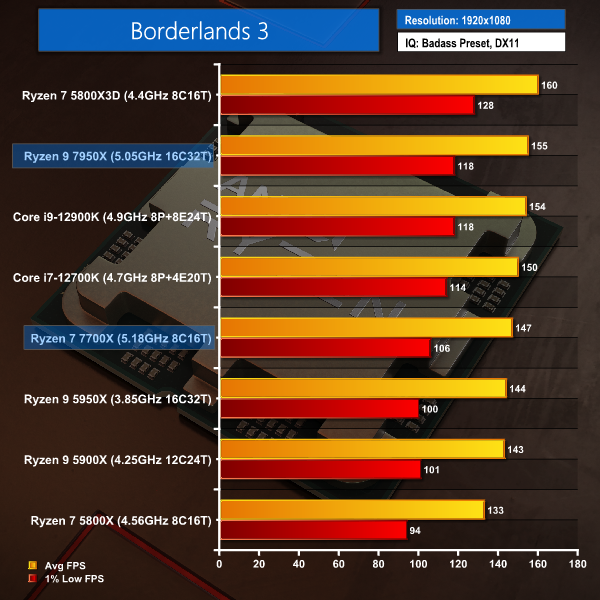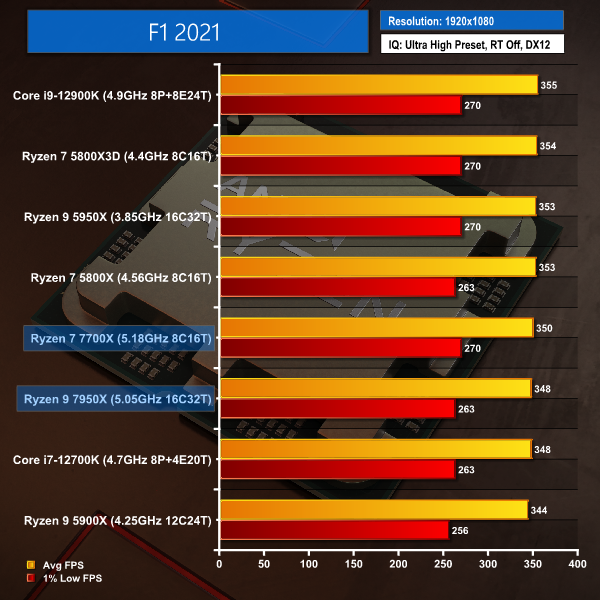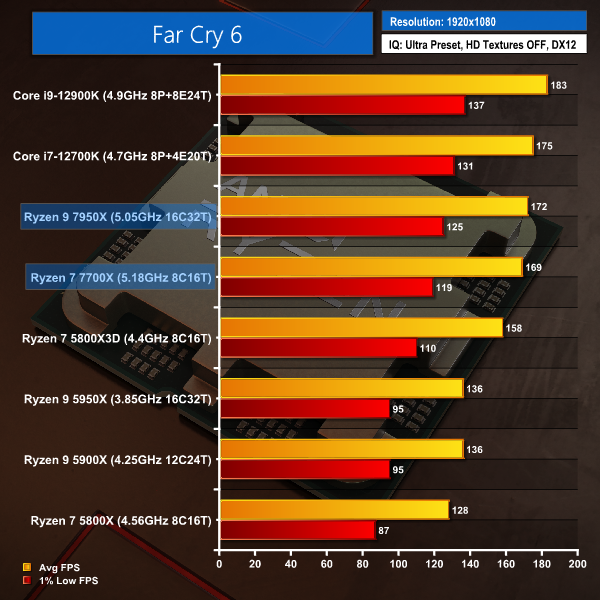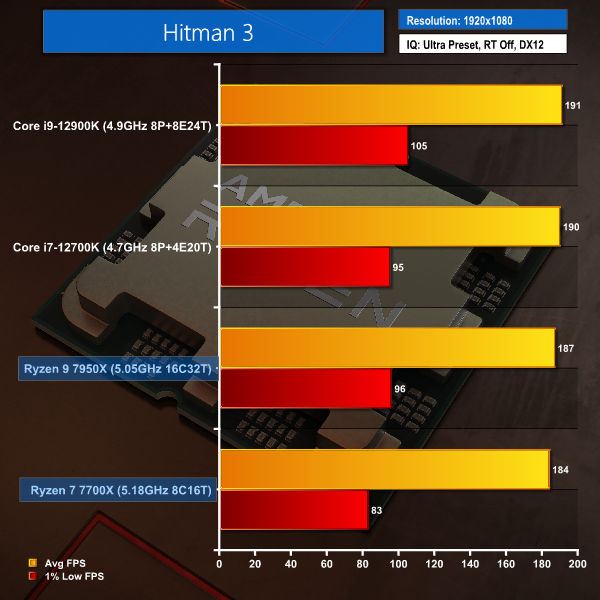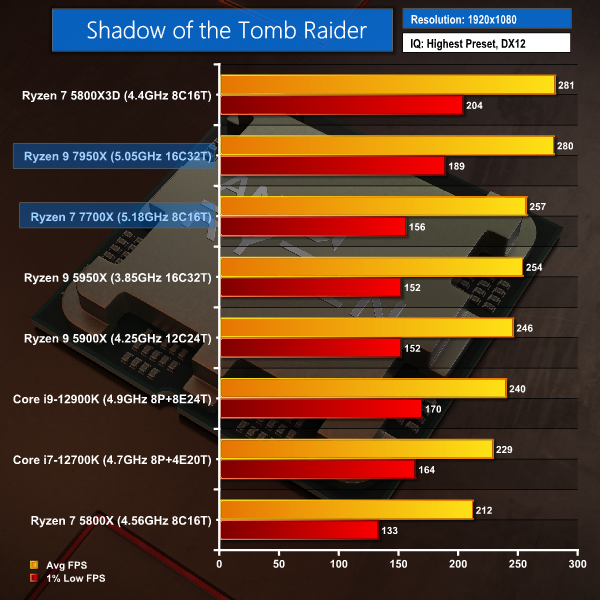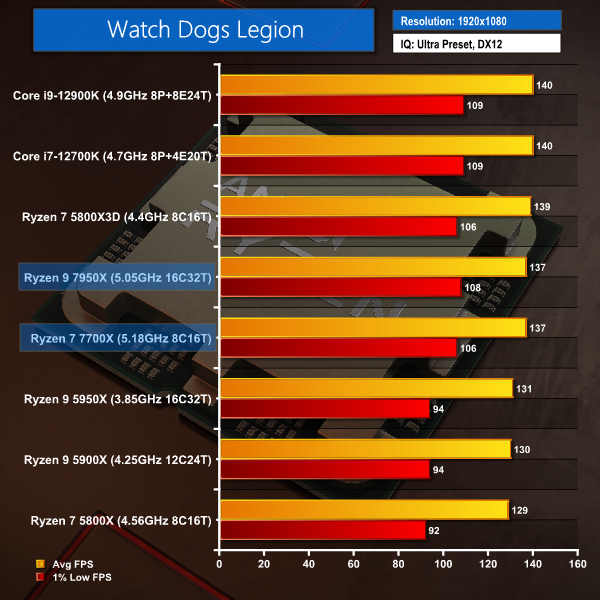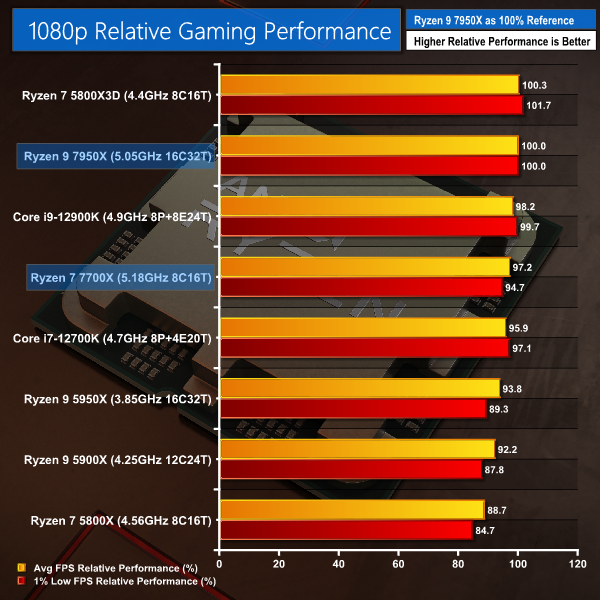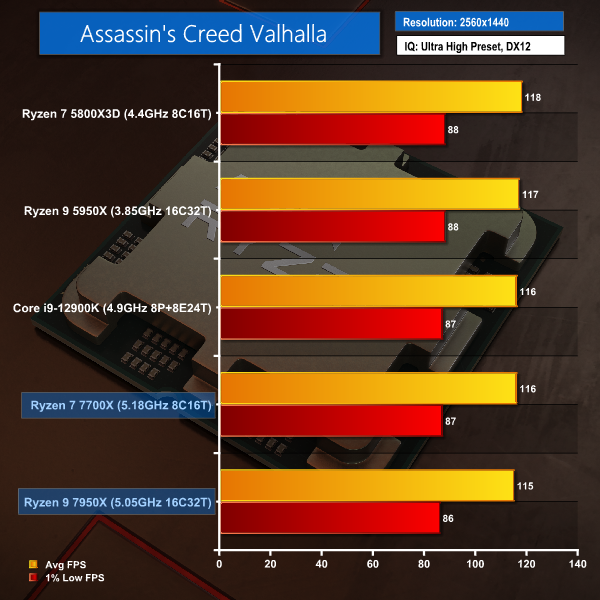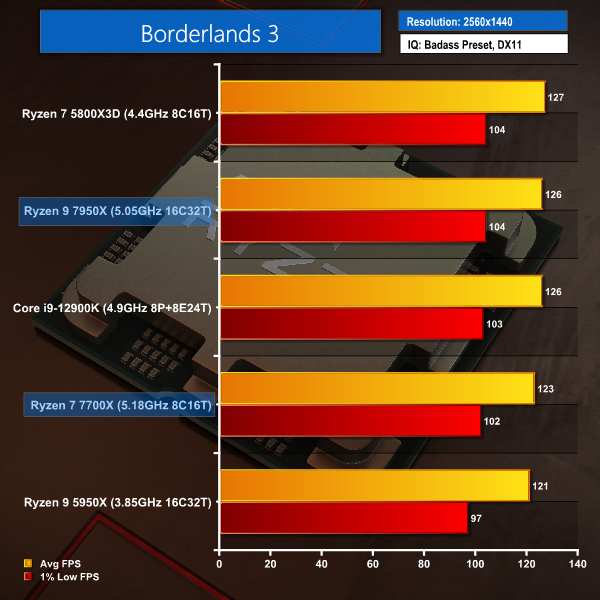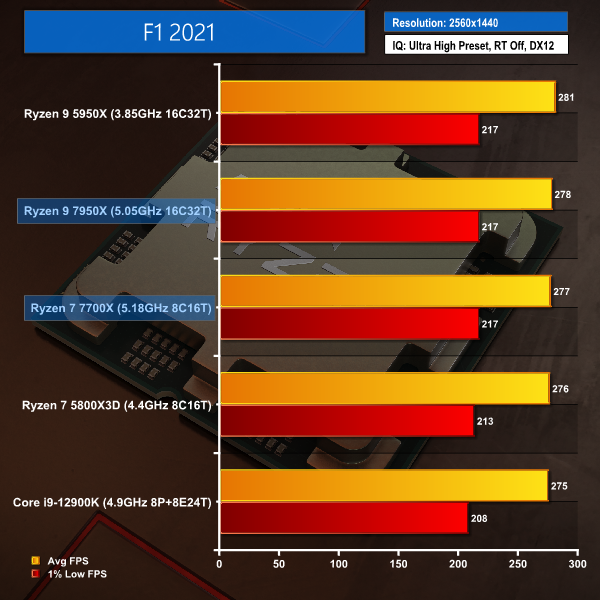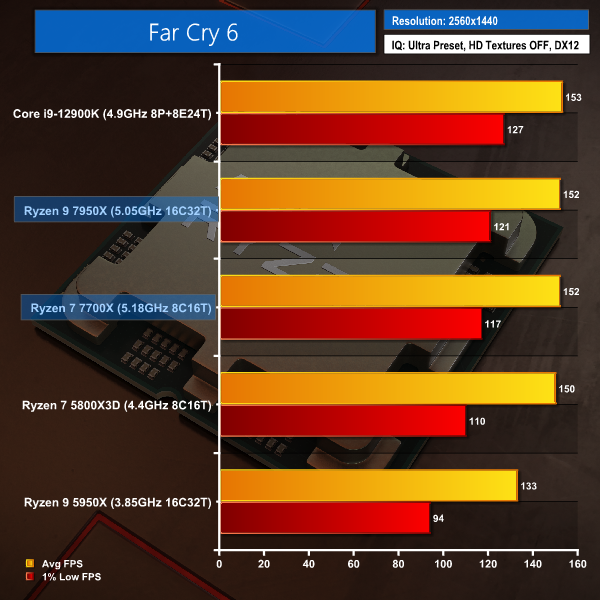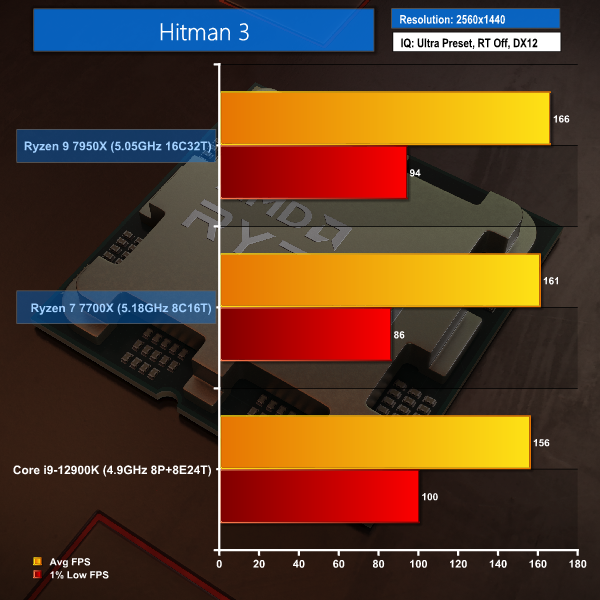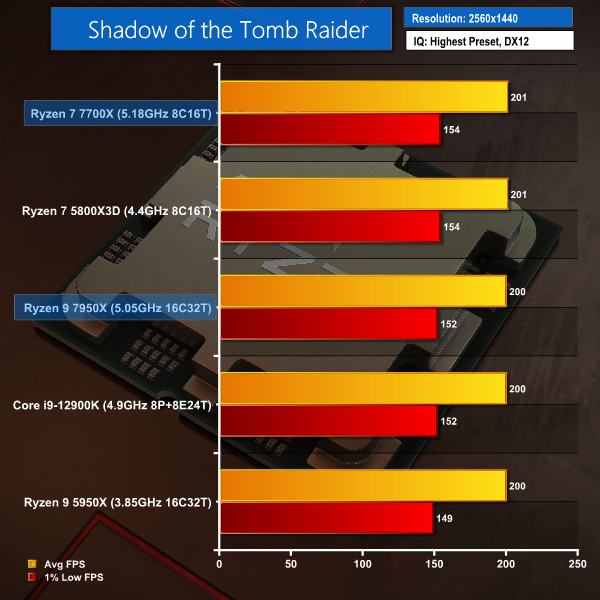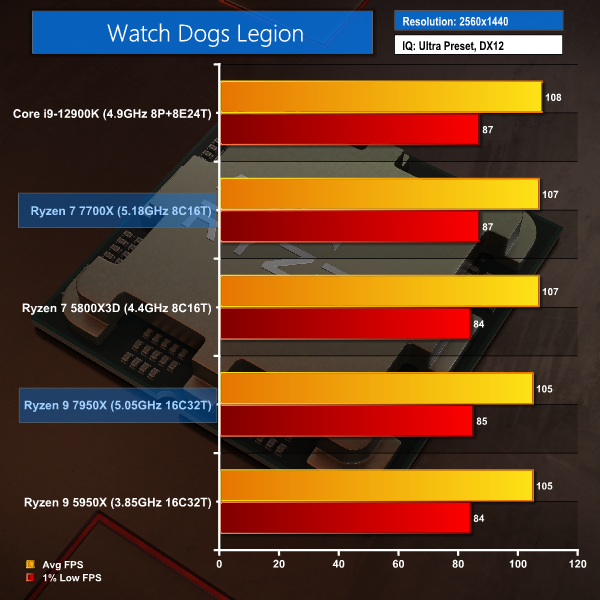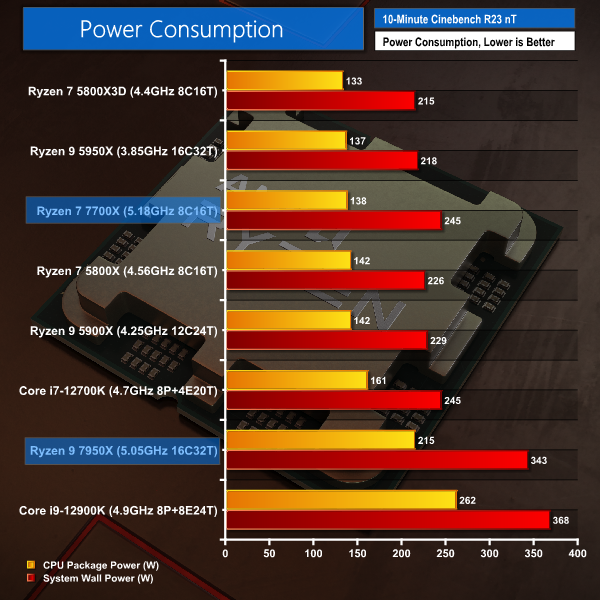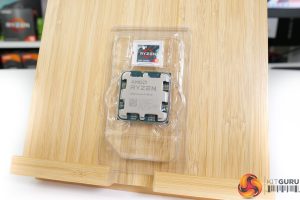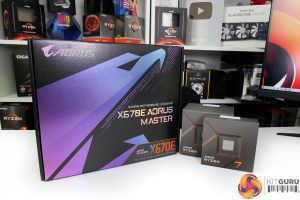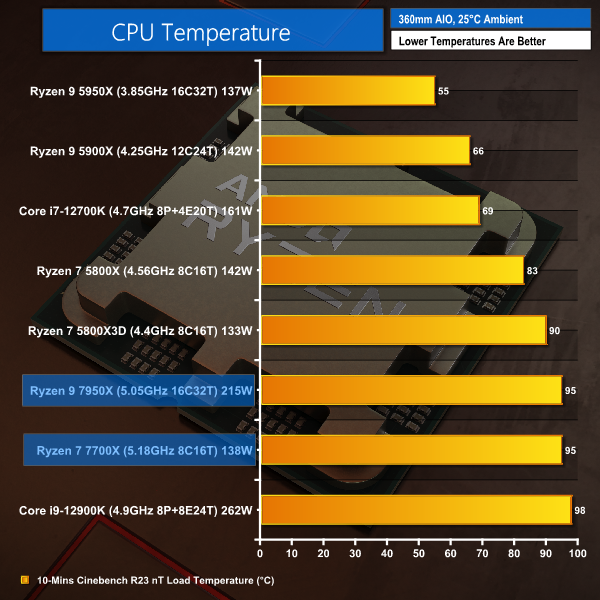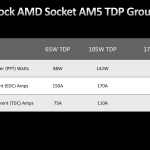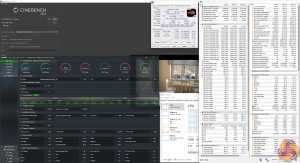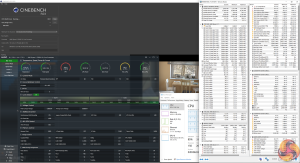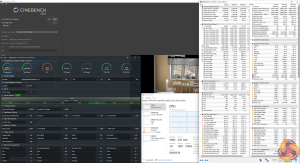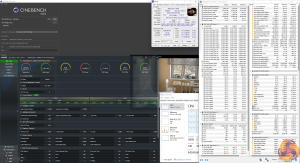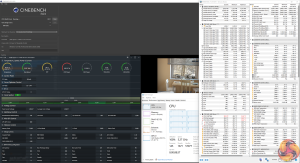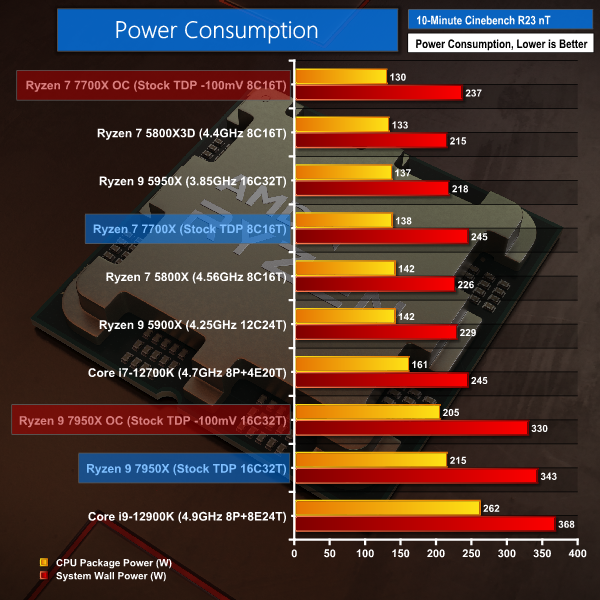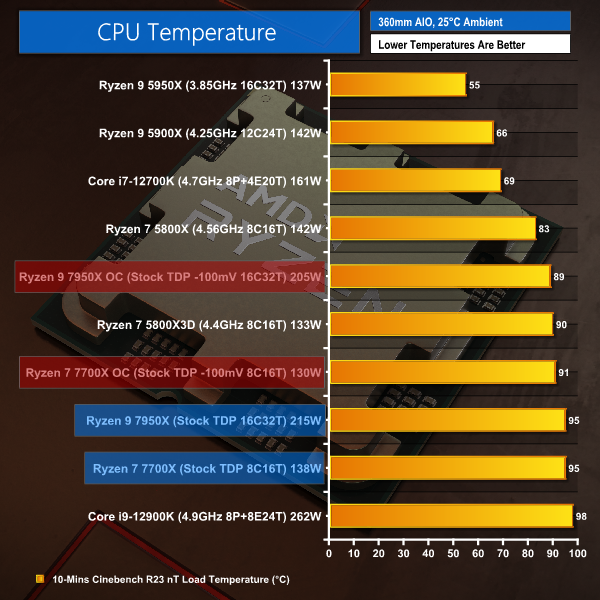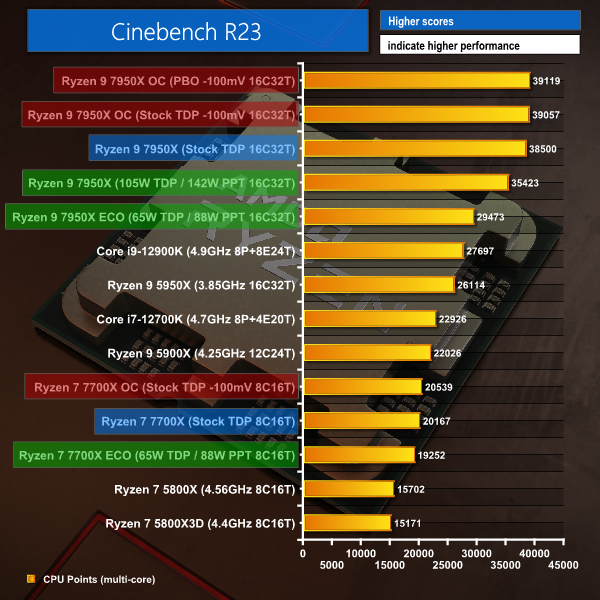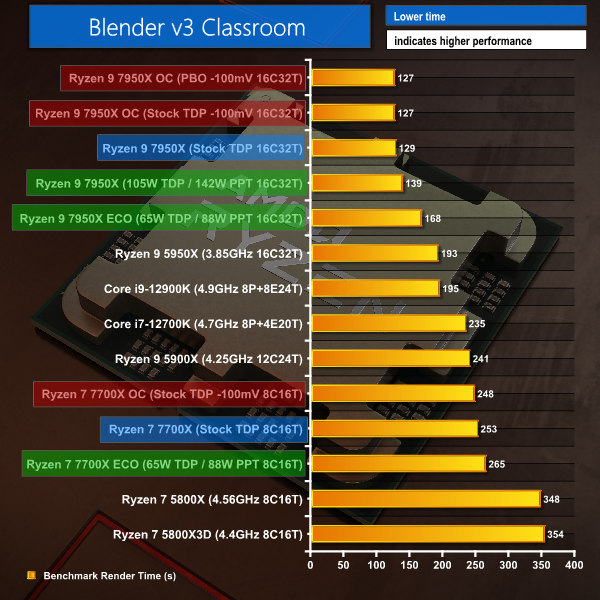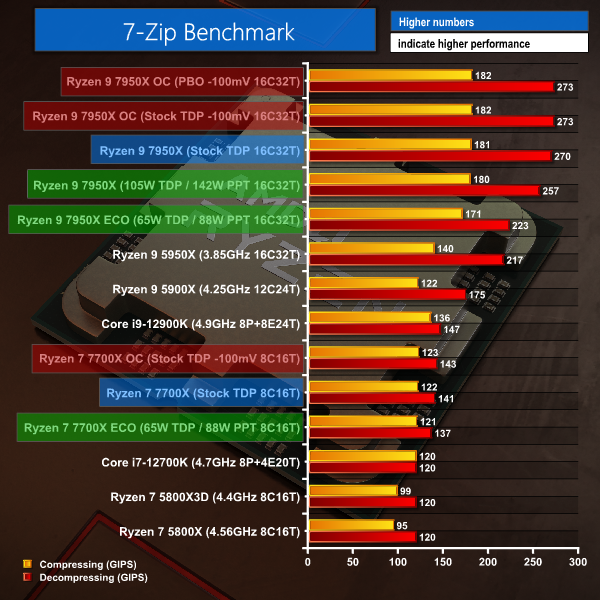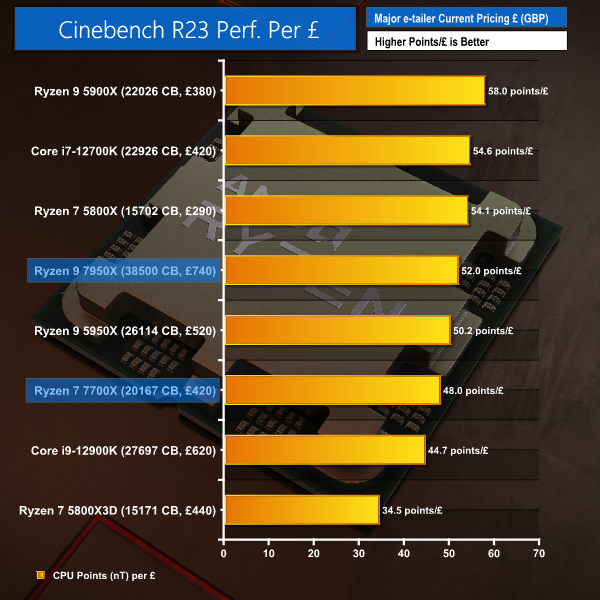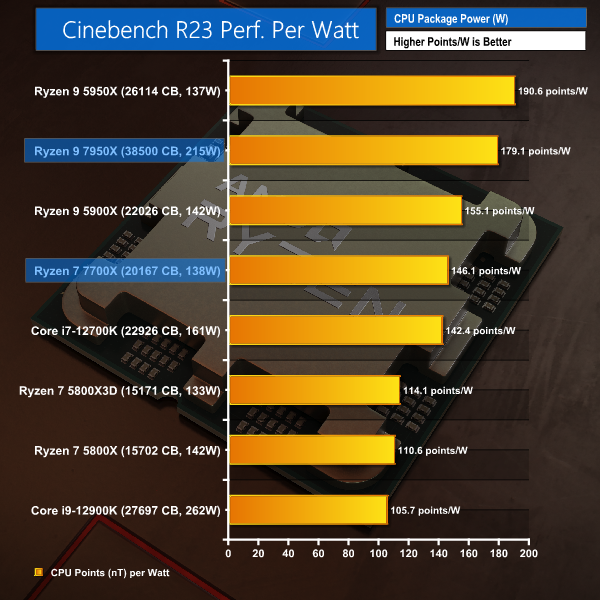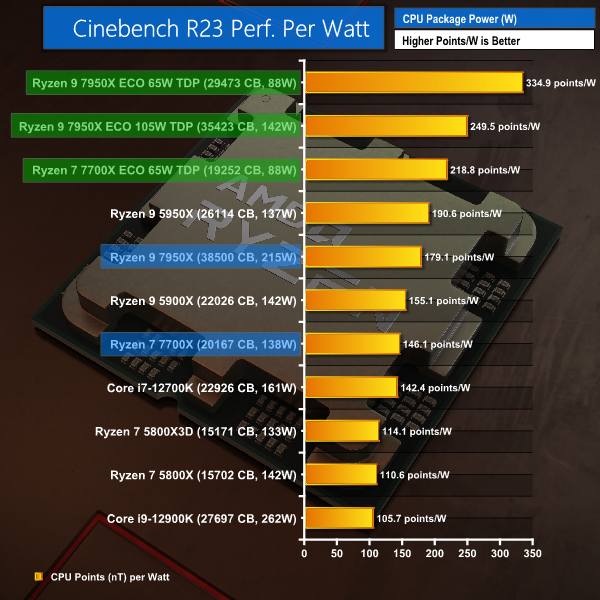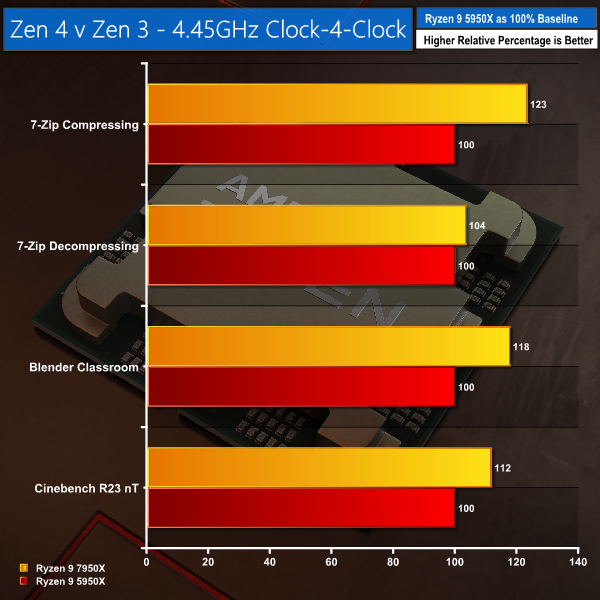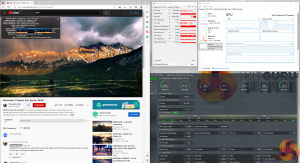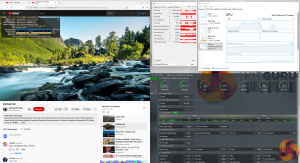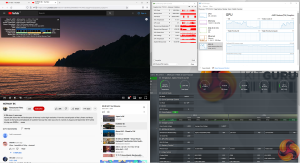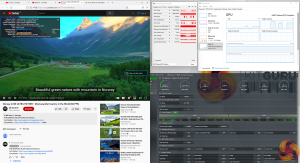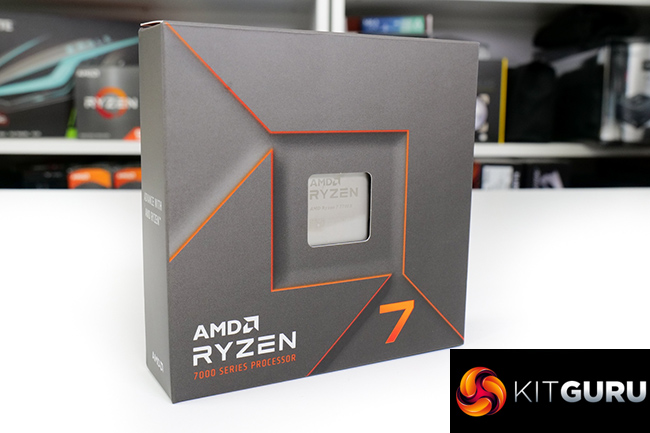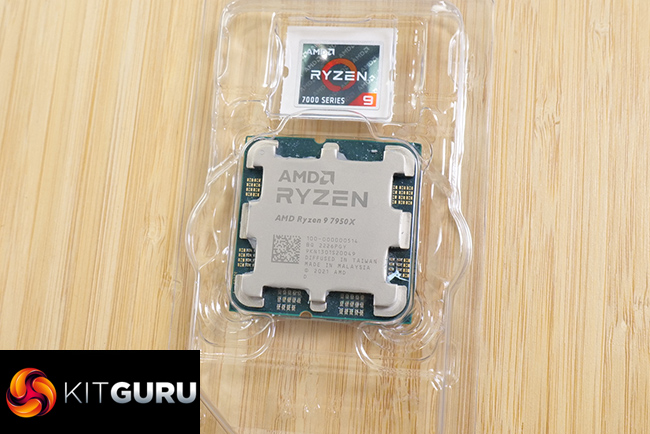AMD launched its Ryzen 5000 – Zen 3 – desktop processors back in late 2020. Coupled with the venerable AM4 platform, the variety of 7nm-built chips have proven incredibly successful. But that AM4 platform has been around for six years. It’s time for an update. Enter the new AM5 platform, with the first chips for this new platform, the Zen 4 Ryzen 7000 series, launching today.
We are examining the 16-core Ryzen 9 7950X flagship and the 8-core Ryzen 7 7700X. The 12- and 6-core reviews will follow in the near future. With a new underlying – Zen 4 – architecture, DDR5 and PCIe Gen 5 support on the AM5 platform, and manufacturing using TSMC’s 5nm process node, let’s take a closer look at the £739.99 Ryzen 9 7950X and the £419.99 Ryzen 7 7700X.
AMD's Ryzen 9 7950X has 16 cores and 32 threads with 64MB of L3 cache and 16MB of L2. This 5nm, dual-CCD chip features a rated base clock of 4.5GHz and a maximum boost clock up to a lofty 5.7GHz. A 170W rated TDP means up to 230W of stock-clocked package power is allowed. That is a large uptick versus previous Ryzen chips which mandates no included CPU cooler, as is the case for all Ryzen 7000 series chips.
The $699 USD Ryzen 9 7950X will sell for £739.99 including VAT in the UK. That’s similar to the launch price of the Ryzen 9 5950X. Competition comes in the form of the incumbent Ryzen 9 5950X at £520 currently, as well as the £620-£700 Core i9-12900K or KS on the advanced, DDR5-capable Z690 platform. Until Intel 13th Gen Raptor Lake launches shortly, that is.
AMD's Ryzen 7 7700X has 8 cores and 16 threads with 32MB of L3 cache and 8MB of L2. This is a single-CCD chip, so it just has the 5nm-fabbed core chiplet alongside the 6nm-built IO Die. Base clock is rated at 4.5GHz with maximum boost listed as 5.4GHz thanks to its 105W TDP.
The $399 USD Ryzen 7 7700X will sell for £419.99 in the UK.
Competition for the new 8-core comes from several vectors; the £380 Ryzen 9 5900X and £440 Ryzen 7 5800X3D on the affordable AM4 platform, in addition to the £430 Core i7-12700K on the advanced Z690 platform. Once again, until 13th Gen replaces it shortly.
With the two processors on review today having been overviewed, let's take a deeper look at the Zen 4 architecture and AM5 platform.
Zen 4 architecture
Let’s start out with a quick overview of the new Zen 4 architecture.
We have already written several article on Zen 4 – including an announcement piece from August 2022. So, make sure you check out the previous content for more details.
According to AMD, the key design goals for the Zen 4 architecture focused on efficiency gains, latency improvements, and better performance in terms of frequency and IPC.
Changes to the cache structure allow AMD to enhance the data flow and reduce latency. One key area to this point is the doubling of L2 cache capacity to 1MB per core instead of 0.5MB per core on Zen 3.
Front-end, execution engine, and load/store advances are achieved via various measures. The enhancements are designed to improve the data flow for the new Zen 4 core versus Zen 3. And that’s particularly useful for better utilising the downstream resources whilst also reducing latency in the underlying architecture, particularly with that larger slice of L2 cache.
Another noteworthy enhancement to Zen 4 is AVX-512 support. This is technically handled via a double-pumping of the 256-bit wide data path, rather than a single operation, because AMD didn’t want to spend the core area of a full 512-bit data path.
While AVX-512 support is a cool inclusion, we have seen from Intel’s adjustments that it isn’t really a significant benefit for the consumer market currently. Zen 4 servers on the other hand – they’ll like that alongside BFloat16.
Ryzen 7000 CPU Configuration
The Ryzen 7000 chips use 8-core CCXs built on the TSMC 5nm process node.
The individual Core Complexes feature a 32MB slice of L3 cache – as we saw with Zen 3 – but no 3D V-Cache like we saw with the 5800X3D. We’ll have to wait for the V-Cache chips because AMD said they didn’t want to delay these parts.
Each 8-core core chiplet measures in at 70mm2 with 6.50 billion transistors. That’s an area reduction versus the 80.7mm2 Zen 3 core chiplet which featured 4.15 billion transistors. Clearly, the density uptick of TSMC 5nm is substantial.
Aside from density, frequency is another huge improvement from 5nm. We now see boost clocks as high as 5.7GHz on the 16 core chip!
The new Ryzen 7000 Series IO Die is a substantial improvement versus Ryzen 5000.
Fabbed on the TSMC 6nm process node, AMD has gone for a more advanced, more expensive manufacturing option with its Ryzen 7000 IO Die. That’s actually a change of direction versus Ryzen 5000 that was built using significantly older 12nm process technology.
This decision allows AMD to increase the transistor count from 2.09 Billion previously to 3.40 Billion now, alongside a small decrease in die area from 125mm2 on Ryzen 5000 to 122mm2 now. And they jam a bunch more functionality onto the new IO chiplet, too.
We get 28 lanes of PCIe Gen 5, a dual-channel DDR5 memory controller that supports up to JEDEC-5200 and ECC, USB 3.2 and Type-C support, and USB BIOS Flashback.
AMD also includes low-power methodologies borrowed from the Ryzen 6000 Series Mobile processors, such as SOC power states, clock gating, and power gating.
Importantly, the IO Die also features the integrated GPU that features two RDNA 2 Compute Units.
When we asked AMD about this inclusion during their tech day in Austin, Texas, the response was quite clear in that this was included to allow them to sell partner systems to businesses who require iGPU capabilities for powering a basic monitor.
As we have seen on the Intel side, though, the inclusion of a modern iGPU also has the benefit of allowing for competent media encode and decode capability
We have some hands-on testing for the iGPU later in this review.
Of course, it’s not just the new Ryzen 7000 series processors that are launching today, as the new chips sit on AMD’s new AM5 platform
The new 1718 pin LGA AM5 socket features a denser pin array for better power capability and improved signal integrity for high-speed interfaces like DDR5 and PCIe Gen 5.
Now, we see chips with TDPs up to 170W out of the box, which means 230W of package power delivered under stock conditions. That’s a substantial uptick versus the 142W peak package power delivery for stock AM4 chips.
AM5 package size is the same 40mm x 40mm as AM4. AMD could have done with a bigger area to work with but decided that a instead unique heatspreader design to permit CPU cooler backwards compatibility was a worthwhile compromise.
The new platform also gets some improved sensor data feed through for power and temperatures. This should improve operations in some domains versus previous Ryzen chips.
AMD's AM5 supports DDR5 and DDR5 only.
AMD wasn’t interested in adding DDR4 support, as Intel does. This was because they’d rather drag the market towards the transitioning to DDR5 instead of supporting the older memory technology. And that’s because the bandwidth and throughput improvements of DDR5 are very much essential to AMD’s platform design.
There is technically ECC support for memory, but this will depend upon motherboard vendor implementation.
As far as frequencies go, AMD support up to 5200MHz JEDEC by default. Though, when we asked about 2 DIMMs per channel speed during the Tech Day, this was highlighted as 3600MHz nominal, and we’ve yet to see any information suggesting otherwise.
Of course, actually usable speeds are high. AMD is suggesting that the new memory sweet spot is DDR5 6000MHz with tight latencies in 2x16GB form. And it is doubling-down on this point by partnering with memory vendors to implement EXPO – which is essentially the AMD alternative to XMP that the company believes is more open and better suited for the AMD platform.
A critical adjustment on the memory subsystem is the decoupling of the Infinity Fabric clock and the Memory Controller clock.
With previous Zen, memory clocks above 3600MHz would result in a divider being applied to the Infinity Fabric clock, thus reducing its effective speed and imparting a significant latency penalty. Now, the Infinity Fabric clock is no longer linked with the memory controller clock.
This means that the Infinity Fabric is generally maintained at 2000MHz while the memory controller runs at 2400MHz for DDR5-4800 or 2600MHz for DDR5-5200 or 3000MHz for DDR5-6000.
Above 6000MHz RAM speed and the memory controller will run at a 2:1 divider. So, 6000MHz is a sweet spot, while DDR5-6200 and 6400 kits realistically sit in the valley of death whereby the slower memory controller will impart a latency penalty. But Infinity Fabric is decoupled so it will stay at 2000MHz frequency, thus the latency penalty is kept to the memory subsystem specifically, and not the processor and platform side of the equation.
TL;DR – AMD reckons that DDR5-6000MHz with nice timings and EXPO configuration is a smart sweet spot. And we’ll test this out some more over the coming weeks and months.
28 lanes of PCIe Gen 5 connectivity are positioned on the new Ryzen 7000 Series processors.
Realistically, this splits out as 24 lanes usable and 4 lanes for connection between the CPU and chipset. AMD increased the count to 24 lanes usable on AM5 versus 20 lanes previously to allow for more CPU-linked storage capacity.
Actual PCIe Gen 5 platform support is convoluted, though.
X670E and future B650E motherboards allow PCIe Gen 5 on expansion slots (graphics cards) and M.2 storage interfaces. Whereas X670 and future B650 non-E motherboards will limit Gen 5 to only the storage connections. Though this may vary as AMD said it isn’t mandated to the motherboard vendors.
With regards to chipsets, we currently have X670E and X670; B650E and B650 will be around in the near future. The ‘E’ suffix denotes enhanced Gen 5 connectivity or (generally) Gen 5 limited to some storage interfaces.
AMD’s processors have four PCIe lanes reserved for linking with the motherboard chipset. However, this link runs at PCIe Gen 4×4 bandwidth instead of Gen 5. AMD told us that a Gen 4×4 is ample given the likely downstream bandwidth requirements, as well as enhanced CPU-direct storage allowances.
The X-series and B-series chipsets differ by their quantity of connection interfaces. But AMD makes a point in highlighting that there are no artificial limitations like overclocking capability or reduced memory frequencies. Realistically, a motherboard vendor could make a B650E motherboard that’s just as good as an X670E option, bar fewer connectivity interfaces.
And those connectivity interfaces that we get through the chipset include PCIe Gen 4 links for storage and expansion cards, flexible SATA 6Gbps connections, and USB interfaces up to 20Gbps. Exactly what is included will vary from vendor to vendor.
The X-series chipset uses a dual-chiplet approach to offer its enhanced connectivity options. These chiplets are daisy-chained, so there could be some bandwidth headaches in some niche – workstation-calibre – use cases, despite AMD’s assurances that these would be unlikely (and they almost certainly will be).
We will be pitting the new Ryzen 7000 series chips against their logical Ryzen 5000 and Intel 12th Gen competitors.
The AM4-based Ryzen 5000 processors will be coupled with 32GB of dual-rank DDR4 3600MHz C16 memory. Both DDR5 platforms use 32GB 6000MHz sets from G.SKILL’s Trident Z5 range. Though the timings differ slightly, with the AMD EXPO kit running at 30-38-38-96 versus the Intel XMP set at 36-36-36-96. This is pretty close between the two sets.
The new AMD processors are tested on Gigabyte’s X670E Aorus Master motherboard featuring the BIOS revision and AGESA profile as supplied and validated by AMD.
Each processor is tested at its default out-of-the-box settings. For the Intel CPUs, unlimited turbo duration as set by the motherboard with XMP enabled is the operating mode. All-core load frequencies for the tested chips are as follows:
- Core i9-12900K = 4.9GHz on the P-cores.
- Core i7-12700K = 4.7GHz on the P-cores.
- Ryzen 7 5800X = around 4.56GHz.
- Ryzen 9 5900X = around 4.25GHz.
- Ryzen 9 5950X = around 3.85GHz
- Ryzen 7 5800X3D = around 4.4GHz.
CPU Test System Components:
- AM5 Motherboard: Gigabyte X670E Aorus Master
- AM5 DDR5 Memory: 32GB (2x16GB) G.SKILL Trident Z5 Neo 6000MHz 30-38-38-96 DDR5
- Dedicated Graphics Card: Sapphire Nitro+ Pure Radeon RX 6950 XT
- CPU Cooler: 360mm AIO liquid cooler
- Power Supply: Seasonic Prime TX-1600
- Operating System: Windows 11 Pro
- AM4 Motherboard: Gigabyte X570S Aorus Master
- AM4 DDR4 Memory: 32GB (2x16GB dual-rank) Corsair Vengeance LPX 3600MHz 16-18-18-36 DDR4 @ 1.35V
- Z690 Motherboard: ASUS ROG STRIX Z690-F Gaming WiFi
- Z690 DDR5 Memory: 32GB (2x16GB single-rank) G.SKILL Trident Z5 RGB 6000MHz 36-36-36-96
Tests:
Productivity-related and Synthetic:
- Cinebench R23 – All-core & single-core CPU benchmark (CPU)
- Blender 3.3.0 – All-core rendering of the Classroom benchmark (CPU)
- HandBrake 1.5.1 H264 – Convert 1440p60 H264 video to 1080p60 H264 using the YouTube HQ 1080p60 preset (CPU)
- HandBrake 1.5.1 H265 – Convert 4K30 100Mbps H264 video to 1080p30 40Mbps H265 using the H.265 MKV 1080p30 preset (CPU & Memory)
- 7-Zip v22 – Built-in 7-Zip benchmark test (CPU & Memory)
- SiSoft Sandra – Memory bandwidth and Cache bandwidth/latency tests (Memory)
- AIDA64 – Memory bandwidth & memory latency (Memory)
- 3DMark – Time Spy and CPU Profile Benchmarks (Synthetic Gaming)
Gaming-related:
- Assassin's Creed Valhalla – 1920 x 1080 & 2560 x 1440, Ultra High quality preset, DX12
- Borderlands 3 – 1920 x 1080 & 2560 x 1440, Badass quality preset, DX11
- F1 2021 – 1920 x 1080 & 2560 x 1440, Ultra High quality preset with TAA and 16x AF, DX12
- Far Cry 6 – 1920 x 1080, Ultra quality preset, HD textures OFF, DX12
- Hitman 3 – 1920 x 1080, Ultra quality preset, RT OFF, DX12
- Shadow of the Tomb Raider – 1920 x 1080 & 2560 x 1440, Highest quality preset, no AA, DX12
- Watch Dogs Legion – 1920 x 1080, Ultra quality preset, DX12 version
Ryzen 9 7950X clocks
Looking at clock speeds for the Ryzen 9 7950X, we noted an average all-core speed of just over 5GHz after a 10-minute looped run of Cinebench R23. This is split as around 5.1GHz on CCD0 and 4.97GHz on CCD1. Cinebench 1T saw a single thread peak at 5.7GHz under our observation.
Over 5GHz average for a 16-core AMD processor out-of-the-box is phenomenal. Clearly, TSMC’s 5nm process node is delivering. Well, 5nm plus copious amounts of power delivery.
To get this 5GHz level during all-core loading, we saw package power delivery operating at 215W. In fact, the only reason it wasn’t jammed closer to 230W is because our 25C room ambient meant that the chip was hitting its 95-degree Celsius threshold even with a 360mm AIO liquid cooler.
That’s some serious power draw and some serious heat. This had better translate into high levels of computational performance.
Ryzen 7 7700X Clocks
The Ryzen 7 7700X runs a little quicker by virtue of its lower core count, single CCD, and therefore greater power allocation per core. Here, we observed a Cinebench nT all-core frequency of just under 5.2GHz after 10 minutes of runtime. And 1T peaked at 5.55GHz for us.
You’d be forgiven for thinking that half the cores running at a similar speed would translate into lower power draw and temperatures. But only one of those assumptions is correct.
With the 7700X drawing just shy of 140W of package power in our testing, we still saw the temperature hitting 95C out-of-the-box with a 360mm AIO. In fact, the 95C temperature threshold being reached once again clipped the power delivery to AMD’s Zen 4 chip.
Of course, AMD’s Precision Boost 2 algorithm is just as smart as ever. So, it’s clear that the formula is for the chips to push up frequency until reaching 95C and then back off the power and subsequent frequency to maintain that temperature threshold.
And in that sense, AMD’s boost algorithm is efficient at aiming to squeeze out all of the performance from the processor… if you’re happy to see 95C, of course.
Blender Classroom
Looking at Blender Classroom rendering performance, the new Ryzen 9 7950X takes a commanding lead at the top of our chart. The next best processors – AMD’s 16-core Ryzen 9 5950X and Intel’s Core i9-12900K – are way behind in this multi-threaded rendering test.
The Ryzen 7 7700X is far less impressive though, with a performance showing that is reasonable, but is slower than its Core i7-12700K and Ryzen 9 5900X competitors. Yes, both of those chips have higher thread counts than AMD’s new 8-core. But they’re positioned at similar price points, too.
Cinebench R23 nT
Cinebench R23 nT shows much of the same trend as Blender. The new Ryzen 9 7590X is an absolute performance monster thanks to its 32 threads pumping away at lofty clock speeds.
But those same Zen 4 clock speed benefits cannot help the Ryzen 7 7700X overcome its thread count deficit versus its realistic price competitors – the 12700K and Ryzen 9 5900X.
As a side note, we checked performance and clock speed sustainability with 10 minutes of Cinebench R23 back-to-back runs, but none of the processors on show today had significant performance drop offs via boost clock speed reductions. So, that’s positive to report.
Cinebench R23 1T
Single-thread performance is superb on the new Ryzen 7000 series chips. The flagship 7950X boosts as high as 5.7GHz and therefore delivers chart-topping performance that is above the speedy Core i9-12900K. And the 5.55GHz peak of AMD’s Ryzen 7 7700X in our testing positions it at third place in our chart – beating its Core i7-12700K competitor and smashing the Ryzen 9 5900X.
The performance uplifts for Zen 4 versus Zen 3 in a single-threaded domain are outstanding.
Handbrake H264
The Ryzen 9 7950X is once again top-dog in our Handbrake H264 test. We see a 26% performance lead versus the Core i9-12900K. And compared to its 5950X predecessor, the 7950X is 35% quicker. They are outstanding results!
The Ryzen 7 7700X is far more competitive versus its price contenders in this test. Now, its performance is within touching distance of the Core i7-12700K and Ryzen 9 5900X. Though it is worth confirming that both of the 7700X’s competitors are technically faster by a small margin.
Handbrake H265
H265 video conversion sees the 7950X present another huge win, with a 19% uplift versus the Core i9-12900K. And now we see the architectural improvements of Zen 4 present the Ryzen 7 7700X with a healthy lead versus the Core i7-12700K and Ryzen 9 5900X.
7-Zip Compression and Decompression
As is the trend at this point, the Ryzen 9 7950X tops our chart by a mile in 7-Zip’s workloads. Compression performance for the Zen 4 16-core is 38% higher than the 12900K and 29% better than the 5950X.
The Ryzen 7 7700X also does well in the compression test when bolstered by the high bandwidth of DDR5 memory. AMD’s new Zen 4 eight-core provides a performance result that matches the 12-core Ryzen 9 5900X, whilst also outperforming the Core i7-12700K.
As always, AMD’s Zen architecture is very strong with decompression performance in 7-Zip. The 7950X is a ludicrous 84% higher performance than the Core i9-12900K, and it outperforms the Zen 3 5950X by a solid 24%, too.
This same architectural proficiency for 7-Zip’s decompression workload boosts the Ryzen 7 7700X to a score that almost matches the Core i9-12900K. This makes it significantly faster than the Core i7-12700K competitor, though it is well behind the performance level of its 12-core Zen 3 contender.
Sandra Memory Bandwidth
AIDA64 Memory Performance
Support for dual-channel DDR5 memory on the new Ryzen 7000 chips provides a significant boost to memory bandwidth scores versus Zen 3 with DDR4.
With that said, Intel’s DDR5-equipped 12th Gen platform offers consistently higher memory bandwidth in our testing. And the margins in favour of Intel’s setup are actually very wide, despite running at the same DDR5-6000MHz configuration.
As a side-note, it is good to see the half-speed write penalty for single-CCD Zen 3 chips not present on the single-CCD Zen 4 Ryzen 7 7700X.
Despite jumping up to higher-speed, higher-latency DDR5 memory, AMD does a good job to keep actual latency numbers in check. Here, we see values that roughly match Intel’s 12th Gen platform in its DDR5 configuration.
3DMark CPU Profile
3DMark Time Spy
If you’re interested in 3DMark numbers, the Ryzen 9 7950X does very well in the CPU Profile benchmark but the Ryzen 7 7700X isn’t appealing versus its competition. The more gaming-focused Time Spy test, however, still favours Intel 12th Gen by a notable margin.
Assassin’s Creed Valhalla shows very little difference between all of these test chips when paired with a Radeon RX 6950 XT graphics card. Ryzen 7000 does will with 1% low frame rates, but there’s very little in it. Other than the Ryzen 7 5800X3D opening up a slight lead versus everything else.
Borderlands 3 has the Ryzen 9 7950X roughly tying with the Core i9-12900K, neither of which can compete with AMD’s 3D V-Cache-equipped Ryzen 7 5800X3D. The Ryzen 7 7700X is a few frames behind the 12700K for average and 1% lows, but it does outperform the Ryzen 9 5900X by a similarly tight margin.
There isn’t too much to say with F1 2021; pretty much everything runs at ludicrously high average and 1% low frame rates. In fact, these numbers are all so high that there’s little value in even comparing 5-7 average FPS differences between the new Zen 4 chips and the 12900K or 5800X3D chart-toppers.
Far Cry 6 continues its historical favouring of the Intel architecture, though AMD’s new Zen 4 processors go some considerable way in closing the gap. The Core i9-12900K is out in front by a notable margin, but the differences between Ryzen 7000 and the Core i7-12700K are less pronounced.
Interesting in this one is that Far Cry 6 clearly prefers AMD’s new Zen 4 architecture as opposed to a sizable slab of L3 cache, as on the Ryzen 7 5800X3D. This is the first game thus far where we have seen the new 7950X and 7700X comfortably outperform AMD’s best Ryzen 5000 gaming chip.
Despite not working properly on our AM4 test system, we still include some data for Hitman 3. Both Intel 12th Gen chips are strong here – particularly the 12900K with a 1% low FPS number in triple-digit FPS territory. The Ryzen 7 7700X delivers strong performance in isolation – everybody will be happy with 184 FPS average! But its 1% low values are notably behind the Core i7-12700K competitor.
Shadow of the Tomb Raider plays very well on Zen 4, with only AMD’s Ryzen 7 5800X3D outgunning the new Ryzen 7 7950X via a healthy 1% low improvement. The Ryzen 7 7700X drops back in 1% low FPS numbers compared to its 16-core sibling, but the average frame is still very healthy and positions it well ahead of the Ryzen 9 5900X and Core i7-12700K contenders.
Watch Dogs Legion is very tight at the top, but Intel’s 12th Gen chips do come out best in our chart. The two Ryzen 7000 processors roughly match the 5800X3D in this game, though, so that’s a positive result for the newcomers.
When looking at a summary of 1080p gaming performance with Hitman 3 excluded, the new Ryzen 7000 series processors show a healthy improvement versus Ryzen 5000 in general. Of course, that’s excluding the special case of the 3D V-Cache-equipped Ryzen 7 5800X3D.
Intel’s 12th Gen Core competitors are still tough for Ryzen 7000 to deal with, and they will often trade places in our chart.
It’s important to examine which games you are most interested in and how they perform on each CPU. As the Ryzen 7 5800X3D still tends to be the best gaming chip on a game-by-game basis, even if the data creating the relative performance chart doesn’t necessarily highlight that trend particularly clearly. This is mainly due to Far Cry 6 being such a performance hit for Zen 3 processors.
Now focussing on 1440p results – a more appropriate resolution for high-end gaming hardware. Here, we expect to see the performance margins squeezed as the effect of GPU performance saturation holds a greater influence.
Assassin’s Creed Valhalla is basically the same performance across the board, particularly when error margins are factored in.
Borderlands 3 shows roughly the same trend, though the three top-tier performers – Ryzen 7 5800X3D, Ryzen 9 7950X, and Core i9-12900K – do look to be slightly better choices.
F1 2021 runs at lofty frame rates on a potato, so any of the chips will be absolutely fine here, even though the Core i9-12900K is technically a small percentage behind that Ryzen pack.
Massive GPU load imparted by the 1440p resolution basically nullifies Intel’s technical advantage in Far Cry 6. With that said, the Core i9-12900K does show tangibly higher 1% low values. As do both Ryzen 7000 chips versus the Ryzen 7 5800X3D.
Hitman 3, switches its hierarchy at 1440p compared to 1080p. Now, the AMD Ryzen 7000 processors are tangibly quicker than the Core i9-12900K in terms of average frame rates. But the Intel processor continues to show excellent 1% low performance that beats both of the Zen 4 parts by a considerable margin.
Shadow of the Tomb Raider is basically the same across the fastest cohort of gaming processors – the Ryzen 7000 chips, Ryzen 7 5800X3D, and Core i9-12900K.
And there isn’t much to differentiate between any of these chips in Watch Dogs Legion at 1440p, particularly when accounting for run-to-run variations.
To summarise our 1440p gaming results, you really aren’t going to notice any worthwhile differences between Ryzen 7000, Ryzen 7 5800X3D, and Core i9-12900K unless you have copious amounts of GPU horsepower that can push to ludicrously high frame rates.
For CPU load results, we read the power draw after running 10 minutes of the Cinebench R23 nT all-core rendering test. The same test parameters are used for temperature readings.
The power consumption of our entire test system (at the wall) is shown in the chart. We also include the reported CPU Package Power.
Power Consumption
Power draw readings are accurate to around +/-5W under heavy load due to instantaneous fluctuations in the value.
Looking at a comparison of power draw after 10-minutes of Cinebench nT loading, we can see just how thirsty the new Ryzen 9 7950X flagship is set to be.
215W of package power – because the 360mm AIO in a 25C ambient could not maintain 230W – is a very lofty power draw! This was almost 350W from the wall, and that’s before the GPU load is added into the equation.
In fact, only the Core i9-12900K running under the motherboard vendors’ ludicrous power settings demanded more energy. The 7950X’s power consumption increase versus its Ryzen 9 5950X predecessor is roughly 50%.
With a 105W TDP limiting package power delivery to 142W maximum, the Ryzen 7 7700X is clearly less juicy than its bigger brother. And because of that 142W allowance, its power consumption falls very much in line with the Ryzen 5000 series predecessors.
It’s also far more power friendly than the unleashed-mode Core i7-12700K to the tune of more than 20W.
As a note, it looks like there is clearly plenty of further optimisation for platform power draw to be made on the new AM5 motherboard.
We will take a closer look at differing power draw levels of the X- or B-series chipsets when the time comes. And when BIOS and platform updates have been made available, we’ll be in a better position to examine AMD’s claims of improved energy efficiency under idle-type conditions.
AMD made it clear that they wanted to remove the power shackles of the high-end CPUs so that Precision Boost 2 could squeeze out all the performance for buyers. The result of this decision is very lofty power levels at the high end.
In isolation, that’s absolutely fine if the performance and tweaking warrants such lofty power draws but also scales with different coolers – as Precision Boost 2 will.
We criticised the Core i9-12900K for high power draw that mandates expensive cooling. But that was more in relation to its inability to convert power consumption into market-leading multi-core performance. AMD's Ryzen 9 7950X does indeed convert its high power draw into market-leading multi-core performance.
Temperatures
Temperature recordings were taken using 360mm AIO CPU cooler. Ambient temperatures were around 25°C.
Uber-high power consumption for the Ryzen 9 7950X unsurprisingly translates into extremely high temperature levels. And just as we saw with Ryzen 5000, the dense, concentrated heat-load applied to the eight-core processor also translates into high temperature levels for Ryzen 7 7700X.
There’s nothing inherently wrong with these chips running at 95C, because that’s what Precision Boost 2 is allowing in order to squeeze out more frequency. Just like there’s nothing inherently wrong with the Core i9-12900K being close to 99C.
The key challenge comes from a CPU cooling perspective.
Not only will you need high-end cooling to get the close to even maximum stock-clocked performance from the processors, but the motherboard fan speed curve control algorithm will typically read 95C and slam the fans up to their maximum RPM. So, tuning a system for lower noise operation will certainly be more nuanced and hands-on versus the sub-70C Ryzen 9 5000 chips or the reasonable Core i7-12700K.
At least we don’t see any signs of concern for heat extraction from the soldered heatspreader on Ryzen 7000.
With both Ryzen 7000 processors running at 95C even under stock conditions, we clearly had no real headroom for manual overclocking – we’d already hit our thermal limits.
As such, our tuning formula focussed on two factors;
- Reduced TDP modes to see how each chip operated under more tolerable power limits
- Undervolting, to see if we could reduce the thermal load in order to force PB2 to give us higher frequency
Eco Modes:
For the reduced power modes, we set the Ryzen 9 7950X at 105W TDP and 65W TDP.
105W TDP – which is 142W package power – had the chip running at roughly 4.7GHz averaged across the sixteen cores. That’s a roughly 300MHz decrease versus the stock levels, which is certainly very tolerable.
65W TDP – which is 88W package power – had the chip running at just under 3.9GHz average.
Almost 4GHz on 16 high-performance cores for 88W of package power is also very tolerable, particularly for workstation or home server type usage.
The Ryzen 7 7700X was set to 65W TDP Eco mode, which once again delivered 88W of package power. This resulted in an all-core clock speed of around 4.95GHz – just over a 200MHz drop versus stock settings.
Undervolting
For undervolting, we did this in the UEFI by applying a -100mV offset to the processor.
For the Ryzen 9 7950X, this resulted in a frequency uptick of a just under 150MHz during Cinebench all-core loading. The chip now operated slightly below 5.2GHz on all 16 cores.
For the Ryzen 7 7700X, the same -100mV undervolt resulted in a 100MHz improvement so that the processor now ran at 5280MHz sustained.
It’s worth noting that applying Precision Boost Overdrive whilst undervolting delivered no tangible improvement to frequencies during our testing.
Manual Overclocking Power and temps
Package power dropped by around 10W for both Ryzen 7000 chips when undervolted by 100mV. And alongside the frequency bumps, both processors also manage to stray away from their 95C limits.
It was the combination of reduced power draw and operating temperature that allowed for the frequency gain via undervolting.
Manual overclocking performance
Undervolting results would imply that there is a smidgen more performance headroom to be squeezed out of both chips as BIOS updates improve voltage targets. But it’s the reduced power and temperature numbers that are greater benefits.
Reduced TDP modes are clearly where the Ryzen 9 shines.
At 105W TDP or 142W allowed package power in Cinebench – the same as the Ryzen 9 5950X it replaces – AMD’s new flagship is 28% quicker than the Core i9-12900K and 36% faster than the Zen 3 16-core.
Even when severely limited to 65W TDP and 88W package power, the 7950X still maintains a healthy lead over the Core i9 and Ryzen 9 5950X – that’s remarkable!
The Ryzen 7 7700X also fairs well at reduced power levels by maintaining a high percentage of its stock performance. But that chip’s market segment has far more direct contenders. Thus the added power of a 105W TDP is necessary to better compete with the Intel 12th Gen and AMD Ryzen 5000 challengers.
Cinebench Performance Per £ GBP
Examining the productivity performance value through the guise of Cinebench performance per £, we see the reoccurrence of an old trend for new-versus-old AMD products during launch times.
The current stellar deals for AMD’s Ryzen 5000 processors offer up tough competition to the new Ryzen 7000 chips. But what is different this time is that Intel’s Core i7-12700K proves to be a well-priced thorn in the side of the Ryzen 7 7700X.
The Ryzen 7 7950X offers good productivity value, despite this metric being somewhat unimportant for a flagship product. But the more budget-conscious buyer stumping up for a roughly £400 chip may have a tough time going for the Ryzen 7 7700X when looking purely at this chart.
Cinebench Performance Per Watt
Top of the performance per Watt chart is AMD’s venerable Ryzen 9 5950X but the new Ryzen 9 7950X is not far behind.
This is an interesting point as the new 16-core flagship certainly isn’t friendly when it comes to power draw numbers. But it does deliver outstanding multi-threaded performance from those lofty levels of power consumption, so I guess that’s absolutely fine.
The Ryzen 7 7700X also does reasonably well in terms of efficiency, sitting between its two primary competitors.
The Ryzen 9 5900X delivers more performance for slightly more power and therefore beats the Ryzen 7 7700X’s efficiency score. But the Core i7-12700K delivers its higher level of performance with considerably more power used and therefore cannot match the 7700X’s efficiency.
Cinebench Perf Per Watt inc. Eco Mode
And if we now switch up the performance-per-Watt chart to include numbers when running the Ryzen 7000 chips in reduced power – ECO – modes, we see a very different pattern.
We know that the Zen architecture has always been particularly strong at lower clock speeds and TDP levels; the performance scales very well when frequency and therefore power are reduced.
What is particularly interesting though is the Ryzen 9 7950X at the previous flagship TDP level of 105W or 142W package power. Efficiency here goes through the roof, yet we only see a modest reduction in Cinebench performance. The same point can be made for the Ryzen 7 7700X when running at its 65W TDP or 88W package power mode.
Where the biggest exclamation point is made, though, is with the Ryzen 9 7950X running at 65W TDP or 88W package power mode. AMD really weren’t exaggerating when they said that Zen 4 excels at 65W TDP!
We wanted to look at a clock-for-clock comparison to make a quick assessment on the Zen 4 architectural performance versus Zen 3. As such, we glued both 16-core chips – the Ryzen 9 7950X and Ryzen 9 5950X – to 4.45GHz and ran a few benchmarks.
7-Zip compression was particularly favourable towards the new 16-core part with a 23% relative performance lead, but this will have also been skewed heavily by higher-bandwidth DDR5 memory.
7-Zip decompression was far less favourable and doesn’t seem to put forth a particularly high uptick for Zen 4.
Rendering seldom places significant emphasis on memory bandwidth in Blender. As such, the 18% clock-for-clock performance lead observed by the new 16-core processor is a pretty reasonable depiction of the Zen 4 vs Zen 3 improvements.
And Cinebench R23 nT with a 12% increase emphasises this Zen 4 vs Zen 3 comparison further.
The clock-for-clock comparison between Zen 3 and Zen 4 is interesting. Clearly, new, high-bandwidth DDR5 memory skews the results a little. But our testing does indicate that the new Ryzen 9 7950X is double-digit percentage points better than the Ryzen 9 5950X it replaces in tasks such as multi-core rendering.
For Ryzen 7000, the IO Die includes the integrated GPU that features two RDNA 2 Compute Units.
AMD included this iGPU to allow them to cater for businesses who require iGPU capabilities for powering a display, without the need for a dGPU. As we have seen on the Intel side, though, the inclusion of a modern iGPU also has the benefit of allowing for competent media encode and decode capability.
Plus, there’s nothing stopping you doing some light gaming – as we did with GTA V at an actually playable frame rate for 1080p Low settings.
iGPU Media Consumption
AV1 decode is supported, as we tested successfully with 4K60 YouTube through Edge. 8K30 AV1 actually worked too, but this was running through the GPU rendering hardware rather than the efficient media decoder.
H264 and H265 4K60 content is handled without hassle through VLC Media player. Plus encode capability is supported.
And if you’re most interested in YouTube playback, we could watch 4K30 and 4K60 VP9 content successfully.
Display connectivity
Focusing on the main task for this iGPU, though – display connectivity, AMD highlights support for up to 4 independent displays. These can be connected via HDMI 2.1, DisplayPort 2.0, and USB-C with DisplayPort Alt Mode. AMD suggests 4K60 display support, which we confirmed. Unfortunately, we have no means to test 8K displays.
Plus, you can run Hybrid graphics if you’d prefer to have the power efficiency benefits of connecting directly to the iGPU, with your dGPU set as a rendering device.
I’d call the RDNA 2 iGPU a nice, deal-sweetener inclusion; many people won’t use it, but many people will also find it valuable at some point, for one reason or another.
I’ll start the conclusion by saying that I think there is a very reasonable debate to be had as to whether both of these processors should have been offered at a TDP step lower than they are. Personally, I appreciate AMD’s decisions to give us pedal-to-the-metal processors that use plenty of power in order to squeeze out every last drop of performance. Fundamentally, this is what Intel has been doing for many generations, albeit to a more extreme level with the most recent chips.
But there are definitely clear caveats to this approach when it comes to power efficiency and cooling challenges. In gaming – fine, go all-out with the processors. But for daily usage, I’d probably tune down the TDP a bit to have a quieter, more power efficient system.
That might sound like some negative feedback on the power and thermal performance of these chips, and I guess it somewhat is.
But it’s also incredibly positive feedback for the sheer performance scalability that AMD’s Zen architecture continues to offer. You can shed about a third of the power draw off the flagship 16-core chip and see Cinebench performance decrease by less than 10%. That’s highly impressive!
We can’t summarise Ryzen 7000 processors without also highlighting the new AM5 platform. Put simply, AM5 looks to be superb and will definitely take the fight to Intel’s LGA 1700 alternative.
AMD now offers users DDR5 memory compatibility, plenty of PCIe Gen 5 connectivity, and the most modern interfaces such as 20Gbps USB.
AM5 motherboards look to be very healthy indeed, but we’ll get into this more with individual reviews. Plus, we’re still waiting on the B650 chipset, as those motherboards could swing the value pendulum in favour of AMD. And the inclusion of integrated GPU connectivity on the new processors is another worthwhile point on the checklist for Ryzen 7000.
Focussing on the Ryzen 7 7700X, I have to say that I am less impressed with this chip than its 16-core sibling.
Firstly, AMD’s new Zen 4 8-core is a huge improvement versus the Zen 3 8-core chips it replaces in terms of productivity performance. But versus the realistic competition – the 12700K and 5900X – the 7700X certainly struggles to shine as it is often just behind matching the competitors rather than beating them.
Power efficiency is another area where the Ryzen 7 7700X doesn’t really excel versus the 12700K or 5900X. Unless you switch to a 65W TDP Eco mode, that is, which I guess you could also do on the previous-gen Ryzen 9.
Gaming performance is good from the Zen 4 Ryzen 7 and is far better than the 5900X. But that Core i7-12700K is a solid competitor for FPS numbers. And at this price point, the Ryzen 7 5800X3D is a contender that’s realistically tough to compete against for purely gaming usage.
So, yes, the Ryzen 7 7700X is a good addition to AMD’s product catalogue, but it will currently have a tough time in the market due to the price point of its primary competitors as well as the presence of the 5800X3D.
In general, I’d say that the Ryzen 9 7950X is a fantastic processor.
Users looking at buying a 16-core flagship are likely those who have actual productivity workloads that will benefit from having such performance on tap. And this is exactly where the 7950X delivers!
You get outstanding multi-threaded performance across the board. The high number of well-designed Zen 4 cores run at incredibly lofty frequencies to deliver remarkable performance gains in rendering applications or video conversion or file manipulation. And if you want to do gaming on the same system during your downtime, the 7950X is generally up there with the best gaming processors on the market.
The clear downsides are the chip’s power consumption and running temperatures. But the performance delivered somewhat warrants such high levels.
In the UK, AMD's Ryzen 9 7950X is £739.99 and the Ryzen 7 7700X is £419.99. These processors will be available from e-tailers such as Overclockers UK.
Discuss on our Facebook page HERE.
Ryzen 7 7700X
Pros:
- Strong gaming performance, particularly versus Zen 3
- Excellent performance efficiency when tuned to 65W TDP
- Competitive option versus the Core i7-12700K
- Outstanding single-threaded performance
- Lofty out-of-the-box frequencies
- Feature-rich AM5 platform and on-chip connectivity
Cons:
- High operating temperatures
- Power consumption could be better tuned
- Expensive setup including AM5 versus AM4
Ryzen 9 7950X
Pros:
- Outstanding computational performance
- Chart-topping single-threaded performance
- Excellent gaming frame rates
- Strong power efficiency, despite high consumption levels
- Remarkable performance in 105W TDP and 65W TDP Eco modes
- Feature-rich AM5 platform and on-chip connectivity
Cons:
- Very high thermals
- Slightly excessive power consumption
KitGuru says: AMD’s Ryzen 9 7950X offers outstanding multi-threaded, single-threaded, and gaming performance numbers. The lofty performance figures more than justify its high power consumption and aggressive thermals. AMD’s Ryzen 7 7700X is also a competitive option on the new AM5 platform, though it has tough alternatives to contend with – particularly Intel’s Core i7-12700K.
Be sure to check out our sponsors store EKWB here
 KitGuru KitGuru.net – Tech News | Hardware News | Hardware Reviews | IOS | Mobile | Gaming | Graphics Cards
KitGuru KitGuru.net – Tech News | Hardware News | Hardware Reviews | IOS | Mobile | Gaming | Graphics Cards


